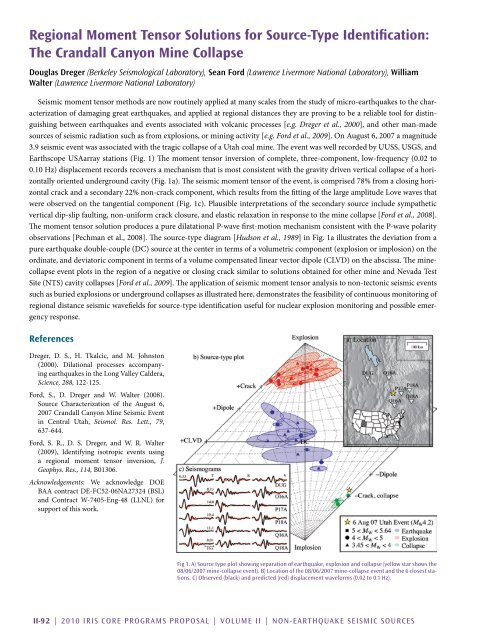Download Volume II Accomplisments (28 Mb pdf). - IRIS
Download Volume II Accomplisments (28 Mb pdf). - IRIS
Download Volume II Accomplisments (28 Mb pdf). - IRIS
You also want an ePaper? Increase the reach of your titles
YUMPU automatically turns print PDFs into web optimized ePapers that Google loves.
Regional Moment Tensor Solutions for Source-Type Identification:<br />
The Crandall Canyon Mine Collapse<br />
Douglas Dreger (Berkeley Seismological Laboratory), Sean Ford (Lawrence Livermore National Laboratory), William<br />
Walter (Lawrence Livermore National Laboratory)<br />
Seismic moment tensor methods are now routinely applied at many scales from the study of micro-earthquakes to the characterization<br />
of damaging great earthquakes, and applied at regional distances they are proving to be a reliable tool for distinguishing<br />
between earthquakes and events associated with volcanic processes [e.g. Dreger et al., 2000], and other man-made<br />
sources of seismic radiation such as from explosions, or mining activity [e.g. Ford et al., 2009]. On August 6, 2007 a magnitude<br />
3.9 seismic event was associated with the tragic collapse of a Utah coal mine. The event was well recorded by UUSS, USGS, and<br />
Earthscope USAarray stations (Fig. 1) The moment tensor inversion of complete, three-component, low-frequency (0.02 to<br />
0.10 Hz) displacement records recovers a mechanism that is most consistent with the gravity driven vertical collapse of a horizontally<br />
oriented underground cavity (Fig. 1a). The seismic moment tensor of the event, is comprised 78% from a closing horizontal<br />
crack and a secondary 22% non-crack component, which results from the fitting of the large amplitude Love waves that<br />
were observed on the tangential component (Fig. 1c). Plausible interpretations of the secondary source include sympathetic<br />
vertical dip-slip faulting, non-uniform crack closure, and elastic relaxation in response to the mine collapse [Ford et al., 2008].<br />
The moment tensor solution produces a pure dilatational P-wave first-motion mechanism consistent with the P-wave polarity<br />
observations [Pechman et al., 2008]. The source-type diagram [Hudson et al., 1989] in Fig. 1a illustrates the deviation from a<br />
pure earthquake double-couple (DC) source at the center in terms of a volumetric component (explosion or implosion) on the<br />
ordinate, and deviatoric component in terms of a volume compensated linear vector dipole (CLVD) on the abscissa. The minecollapse<br />
event plots in the region of a negative or closing crack similar to solutions obtained for other mine and Nevada Test<br />
Site (NTS) cavity collapses [Ford et al., 2009]. The application of seismic moment tensor analysis to non-tectonic seismic events<br />
such as buried explosions or underground collapses as illustrated here, demonstrates the feasibility of continuous monitoring of<br />
regional distance seismic wavefields for source-type identification useful for nuclear explosion monitoring and possible emergency<br />
response.<br />
References<br />
Dreger, D. S., H. Tkalcic, and M. Johnston<br />
(2000). Dilational processes accompanying<br />
earthquakes in the Long Valley Caldera,<br />
Science, <strong>28</strong>8, 122-125.<br />
Ford, S., D. Dreger and W. Walter (2008).<br />
Source Characterization of the August 6,<br />
2007 Crandall Canyon Mine Seismic Event<br />
in Central Utah, Seismol. Res. Lett., 79,<br />
637-644.<br />
Ford, S. R., D. S. Dreger, and W. R. Walter<br />
(2009), Identifying isotropic events using<br />
a regional moment tensor inversion, J.<br />
Geophys. Res., 114, B01306.<br />
Acknowledgements: We acknowledge DOE<br />
BAA contract DE-FC52-06NA27324 (BSL)<br />
and Contract W-7405-Eng-48 (LLNL) for<br />
support of this work.<br />
Fig 1. A) Source type plot showing separation of earthquake, explosion and collapse (yellow star shows the<br />
08/06/2007 mine-collapse event). B) Location of the 08/06/2007 mine-collapse event and the 6 closest stations.<br />
C) Observed (black) and predicted (red) displacement waveforms (0.02 to 0.1 Hz).<br />
<strong>II</strong>-92 | 2010 <strong>IRIS</strong> Core Programs Proposal | <strong>Volume</strong> <strong>II</strong> | Non-earthquake Seismic Sources
















